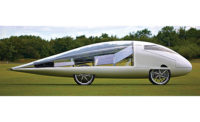Renewable Energy? Metal Welding Plays Key Role

Manufacturers, appliance designers and engineers are seeing viability in renewable energy offerings and also for metal welding equipment for renewable energy applications ranging from solar panels to wind turbine components.
The U.S. solar market had a strong first quarter of what is expected to be another record year for the industry. 723 megawatts (MW) of photovoltaic (PV) capacity were installed in the first quarter of 2013, which represents a 33 percent increase in deployment levels over Q1 2012. The growth in Q1 2013 was driven in part by a record first quarter for both the residential and utility segments, which installed 164 MW and 318 MW respectively. This growth will continue throughout the year with 4,400 MW of PV and 938 MW of concentrating solar power (CSP) are expected to come online in calendar year 2013. All data for this article comes from the Solar Energy Industries Association/GTM Research service and its “U.S. Solar Market Insight: Q1 2013” unless otherwise noted.
U.S. Solar Industry Continues to Boom
The U.S. now has over 8,500 MW of cumulative installed solar electric capacity, enough to power more than 1.3 million average American homes.
The residential market continues to show consistent, incremental growth. Residential installations grew 53 percent in Q1 2013 over the same quarter last year.
Utility installations more than doubled year-over-year as 318 MW came online in the first quarter of 2013.
Falling Costs Make Solar More Affordable
The average cost of a completed PV system dropped by 24 percent over the past year to $3.37/W.
The average price of a solar panel has declined by 60 percent since the beginning of 2011.
While these price drops are beneficial for solar consumers, the sharp fall in prices, due in part by a global oversupply, has put a serious strain on solar manufacturers worldwide.
Wind Turbines, Too
On the wind turbine side, according to Transparency Market Research, “Global Wind Energy & Wind Turbine Market (2011 – 2016),” the global market for wind turbines registered a growth rate of 25 percent CAGR over the last five years. The Global Wind Energy cumulative capacity accounted for 197,039 MW in 2010.Wind turbine is expected to attain market size of USD $93.1 billion in 2016 while wind energy cumulative capacity will rise to 1,750,000 MW by 2030.
So it is not surprising that spot welding system and wire termination systems match these needs because these robust machines are designed to handle a range of non-ferrous welding applications including precise welding of smaller gauge metals and delicate assemblies. They can provide the highest degree of reliability and weld quality; and they are particularly well suited for automation to maximize throughput.
Source: appliance DESIGN
Looking for a reprint of this article?
From high-res PDFs to custom plaques, order your copy today!




